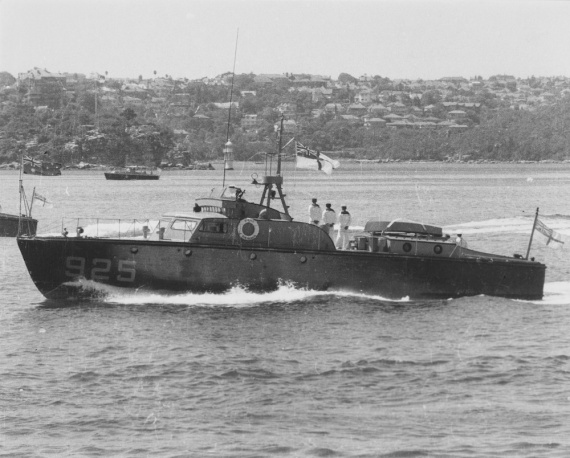HMAS Air Mercy
| Class |
Air/Sea Search and Rescue Vessel |
|---|---|
| Type |
Air-Sea Rescue Launch |
| Pennant |
ASR925 |
| Builder |
Fellows & Stewart Inc, USA |
| Commissioned |
28 February 1945 |
| Decommissioned |
30 July 1946 |
| Dimensions & Displacement | |
| Displacement | 24 |
| Length | 63 feet (19.2 metres) |
| Beam | 15 feet (4.57 metres) |
| Draught | 3 feet 4 inches (1.01 metres) |
| Performance | |
| Speed | Up to 28 knots |
| Complement | |
| Crew | 7-8 including 2 RAAF telegraphists |
| Propulsion | |
| Machinery | Twin Hall-Scott petrol engines |
| Horsepower | 1200 bhp |
| Armament | |
| Guns | 2 x twin Lewis guns |
HMAS Air Mercy was one of 21 air/sea rescue vessels originally built in the USA and Canada between 1943 and 1945, and transferred to the RAN under the Lend-Lease Agreement. These vessels were originally designed as anti-submarine craft but their high speed and manoeuvrability made them ideal as search and rescue vessels. In this role, their hulls were painted black and their upper decks and superstructure painted bright yellow. One vessel, HMAS Air Sprite, was built locally in 1960 to an almost identical design.
Air Mercy was commissioned on 28 February 1945 in Sydney under the command of Sub Lieutenant Edward Johnson, RANVR, and officially listed as a tender to HMAS Madang. Her first few weeks of commission were spent at Garden Island in Sydney preparing for sea and conducting trials before proceeding northwards for Madang, New Guinea, on 23 April in company with her sister ships, HMA Ships Air Hope and Air Speed.
Air Mercy arrived in Madang on 24 June and conducted ASR duties until 20 August when she proceeded to Middleburg Island, Indonesia, to take soundings and survey seaplane moorings. She proceeded to Biak where she again took up ASR duties and rescued ten people adrift in a launch on 11 October, and on 23 October assisted in the rescue operation of a Dutch Catalina crew when their aircraft crashed into Sorido Harbour. There were no serious casualties. She returned to Alexishafen at the end of October for a refit and returned to Biak at the end of December. She departed Biak on 17 February 1946 to begin her voyage back to Sydney where she decommissioned on 30 July 1946.
She recommissioned on 29 April 1949 as a search and rescue vessel operating between Sydney and Jervis Bay and remained listed as a search and rescue vessel until 1957.






